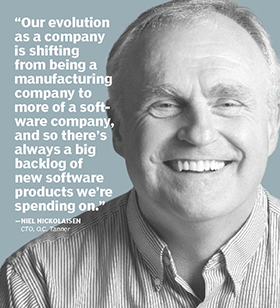
Ronald Hudson - Fotolia
The information technology budgeting process: One CTO's experience
Budget surprises have the power to take a company's yearly plans from smooth to chaotic. Look at one CTO's journey through the information technology budgeting process in 2018.
When reflecting on 2018, Niel Nickolaisen took a deep sigh to consider what was most shocking during his information technology budgeting process. The rapid advancement of technology? The expense of retention? His human resource company, with over 3 million users, is undergoing an evolution from a manufacturing company to a software company, and naturally encountered a few budget surprises. With another year as CTO at O.C. Tanner almost completed, Nickolaisen discusses how his team interacted with a fluctuating 2018 IT budget.
Did you have any surprises in your information technology budgeting process in 2018?
Niel Nickolaisen: A budget shift we didn't anticipate that hit us a bit [were] escalating IT salaries. We had to pay more to recruit and retain than we had planned because, where we live, IT salaries are crazy.
In fact, what we've decided we're going to do for 2019 is just add into our IT budget a retention hold. When somebody comes to us and says 'I'd love to stay but I've got a great offer from another company,' we're just going to hold back about a half a million dollars to respond.
Which is a bigger conflict: retention or acquiring the talent?
Nickolaisen: It's both. We've done reasonably well with finding. In 2018, we made a concerted effort to improve our referrals. We pay a bounty to current employees if they refer us to somebody they know.
We do a lot in outreach, joining user communities and actually sponsoring user communities so we get to know people and they get to know what we're up to, and that's helped with the recruitment. But the retention has been a challenge -- a bigger challenge this year than in previous years.

Have you had any other unanticipated budget shocks this year?
Nickolaisen: One of the biggest surprises was just the increasing demand for our services. I tell my team that we've built about a 30 year backlog of things to do, because everybody wants technology for everything. It's nice to be needed, but that forces us to prioritize pretty heavily.
We've done a lot more replacing vendors and technology than in years past. So a new technology comes along -- something we weren't even thinking of replacing -- a compelling alternative comes along and we started switching more frequently than we had in the past, which sometimes has budget impacts.
Can you recall a specific example of shifting technology that caused an unplanned budget change?
Nickolaisen: For example, we used a combination of data replication appliances and data management software for backup and restore related to business continuity and disaster recovery. Our company did a proof of concept with a new type of product that would do both and also replace other legacy technologies we had in place.
The proof of concept worked well enough that we decided to implement the new thing. Since we did this outside of our normal annual capital expenditure budgeting process, we, in effect, had to pay the costs of the legacy systems as well as the new systems costs -- but only for one year. In the 'out years' we will more than pay for our decision, but it was a temporary shock.
Stay tuned for part two, where Nickolaisen looks ahead to O.C. Tanner's 2019 budget plans and provides an overview.








